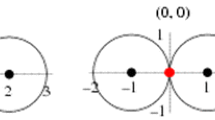Abstract
This is Part 2 of a two-part study of how APOS theory may be used to provide cognitive explanations of how students and mathematicians might think about the concept of infinity. We discuss infinite processes, describe how the mental mechanisms of interiorization and encapsulation can be used to conceive of an infinite process as a completed totality, explain the relationship between infinite processes and the objects that may result from them, and apply our analyses to certain mathematical issues related to infinity.
Similar content being viewed by others
References
Brown, A., DeVries, D., Dubinsky, E. and Thomas, K.: 1998, ‘Learning binary operations, groups, and subgroups’, Journal of Mathematical Behavior 16(3), 187–239.
Cantor, G.: 1955, Contributions to the Founding of the Theory of Transfinite Numbers (translated and provided with an introduction and notes by Philip E.B. Jourdain), Open Court Publishing, LaSalle, IL.
Cornu, B.: 1991, ‘Limits’, in D.O. Tall (ed.), Advanced Mathematical Thinking, Kluwer, Dordrecht, pp. 153–166.
Cottrill, J., Dubinsky, E., Nichols, D., Schwingendorf, K., Thomas, K. and Vidakovic, D.: 1996, ‘Understanding the limit concept: Beginning with a coordinated process schema’, Journal of Mathematical Behavior 15, 167–192.
Dubinsky, E.: 1991, ‘Reflective abstraction’, in D.O. Tall (ed.), Advanced Mathematical Thinking, Kluwer, Dordrecht, pp. 95–123.
Dubinsky, E. and McDonald, M.A.: 2001, ‘APOS: A constructivist theory of learning in undergraduate mathematics education research’, in Derek Holton et al. (eds.), The Teaching and Learning of Mathematics at University Level: An ICMI Study, Kluwer, Netherlands, pp. 273–280.
Dubinsky, E., Weller, K., McDonald, M.A. and Brown, A.: 2005, ‘Some historical issues and paradoxes regarding the concept of infinity: An APOS analysis: Part 1’, Educational Studies in Mathematics, Springer, Dordrecht, 58(3), pp. 335–359.
Edwards, B.: 1997, ‘An undergraduate student's understanding and use of mathematical definitions in real analysis’, in J. Dossey, J.O. Swafford, M. Parmentier, and A.E. Dossey (eds.), Proceedings of the 19th Annual Meeting of the North American Chapter of the International Group for the Psychology of Mathematics Education, Columbus, OH, pp. 17–22.
Galilei, G.: 1968, Dialogues Concerning Two New Sciences (translated from the Italian and Latin by Henry Crew and Alfonso de Salvio), Northwestern University Press, Evanston, IL.
Kamke, E.: 1950, Theory of Sets (F. Bagemihl, trans.), Dover, New York.
Lakoff, G. and Núñez, R.: 2000, Where Mathematics Comes From, Basic Books, New York.
Mamona-Downs, J.: 2001, ‘Letting the intuitive bear upon the formal: A didactical approach for the understanding of the limit of a sequence’, Educational Studies in Mathematics 48(2/3), 259–288.
McDonald, M.A., Mathews, D.M. and Strobel, K.H.: 2000, ‘Understanding sequences: A tale of two objects’, in E. Dubinsky, A. Schoenfeld, and J. Kaput (eds.), Research in Collegiate Mathematics Education IV, American Mathematical Society, Providence, pp. 77–102.
Monaghan, J.: 2001, ‘Young people's ideas of infinity’, Educational Studies in Mathematics 48(2/3), 239–257.
Moore, A.W.: 1995, ‘A brief history of infinity’, Scientific American 272(4), 112–116.
Moore, A.W.: 1999, The Infinite, 2nd ed., Routledge & Paul, London.
Moore, G.: 2002, ‘Hilbert on the infinite: The role of set theory in the evolution of Hilbert's thought’, Historia Mathematica 29, 40–64.
Newton, I.: 1934, The Principia: Vol. 1. The Motion of Bodies (Translated into English by Andrew Motte in 1729. Translations revised and supplied with an historical and explanatory index by Florian Cajori), University of California Press, Berkeley.
Nicholas of Cusa: 1954, Of Learned Ignorance (translated by Germain Heron; with an introduction by D.J.B. Hawkins), Routledge & Paul, London.
Piaget, J.: 1952, The Child's Conception of Number, (G. Gattegno and F.M. Hodgson, trans.), Routledge and Paul, London.
Poincaré, H.: 1963, Mathematics and Science: Last Essays (John W. Bolduc, trans.), Dover, New York.
Quine, W.V.: 1970, Philosophy of Logic, Prentice Hall, Englewood.
Schiralli, M. and Sinclair, N.: 2003, ‘A constructive response to “Where Mathematics Comes From”’, Educational Studies in Mathematics 52, 79–91.
Tall, D.: 1976, ‘Conflicts and catastrophes in the learning of mathematics,’ Mathematical Education for Teaching 2(4), 2–18.
Tall, D.: 2001, ‘Natural and formal infinities’, Educational Studies in Mathematics 48 (2/3), 129–136.
Tall, D. and Schwarzenberger, R.L.E.: 1978, ‘Conflicts in the learning of real numbers and limits’, Mathematics Teaching 82, 44–49.
Tirosh, D.: 1999, ‘Finite and infinite sets: Definitions and intuitions’, International Journal of Mathematical Education in Science & Technology 30(3), 341–349.
Author information
Authors and Affiliations
Corresponding author
Rights and permissions
About this article
Cite this article
Dubinsky, E., Weller, K., McDonald, M.A. et al. Some Historical Issues and Paradoxes Regarding the Concept of Infinity: An Apos Analysis: Part 2. Educ Stud Math 60, 253–266 (2005). https://doi.org/10.1007/s10649-005-0473-0
Issue Date:
DOI: https://doi.org/10.1007/s10649-005-0473-0




